12 valve compound turbo kit
1998 12 valve cummins
5.9 cummins 12 valve for sale
In recent years, the demand for fire-safe fusible link shut-off valves in industrial processing has increased with the improvement of the operating environment for industrial production, the priority is to protect the workers’ lives and the property of owners. Especially under the environmental and safety regulations, THINKTANK’s sales of fire-safe fusible link shut-off valves are increasing year by year. The unique design of Fire-safe valves ensures that valves close tightly to prevent leakage of media in the tremendous heat of an industrial fire. The use of heavy-duty valve bodies, bolts, and UL-approved fuse plates imported from the US adds a great safety factor in different details.
6 Typical Applications of Fusible Link Valves and How Does It Work?
Ball valves are available with metal seals, RPTFE, TFE, and other high temperature resistant materials. All fire ratings can be ordered to meet the requirements of NACE MR-01-75.
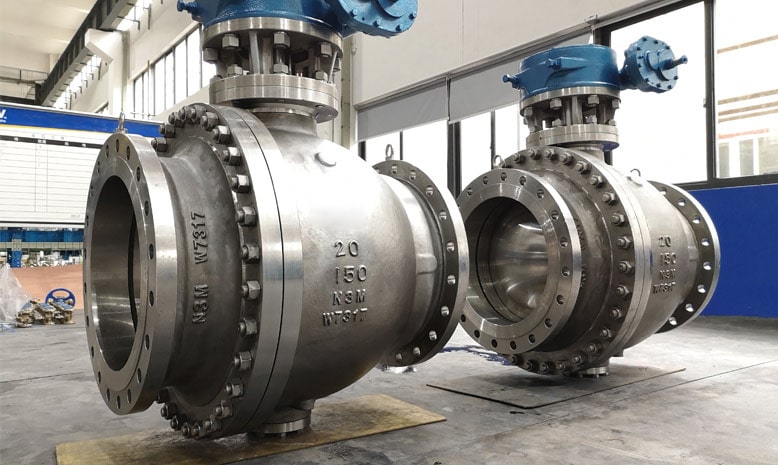
What are Fire-Safe Ball Valves?
The fire-safe ball valve is a unique design that combines a complex sealing design, in case to minimize medium emissions and tight shut off the leakage in a fire situation. This valve has the ability to keep a fail-safe valve position at high temperatures.
Fire-Safety Valve with a Fusible Link
Fire-Safe Ball Valves for All Standards
The fire-safe ball valves meet the requirements of main standards including API 607, EXES 3-14-1-2A, BS 6755-PT2, BS5146 APP.B, and BS 5351 Anti-Static, etc.
Anti-Static Performance
All THINKTANK fire safe valves are designed with a thrust bearing and gasket with carbon-filled TFE or a ball inside of the stem. This excellent sealing material can meet a wide range of operating conditions. Over 3inches fire safe ball valves, the valve stem is made of SS316 material, and it has a top and bottom stem to fix the ball.
Tight Shutoff
When the fire safe ball valve exposes to high-temperature fire conditions, the soft seat material will melt while the resilient metal seat will compensate for the sealing to tight shutoff.
No External Leakage
In the event of a fire, the process fluid is contained within the valve. If the heat of the fire thrusts the bearing into sublimation, the blowout preventer rod forms a metal-to-metal seal with the valve body. The use of standard carbon-filled TFE packing or a steel ball and spring design inside the stem effectively prevents the bonnet from sealing. The use of spring-loaded metal seat compensation makes the valve body seal stable and keeps the media from external leakage in intense temperatures.
Long Service Life
THINKTANK’s fire safe ball valves as manually operated or automated valves have excellent performance, the valve body is designed with two-piece, three-piece flanged, or threaded ends.
Fire Safe 2-Piece Ball Valve
Product: 2-Pieces Full Port Ball Valve
- Valve Size: 1″ to 6″
- Nominal Pressure: ANSI 150/300LB RF
- Max. Pressure: 285/740 PSI at 100ºF
- Body Materials: Carbon steel, Stainless steel
- Connect Ends: Flanged Ends
- Design Standards: ASME B16.34, API 6D, NACE MR-0175
- Testing Standards: Fire Safe, API 607
- Certificate: ISO 9001, CE, API 607.
Product: 2-Pieces Standard Port Ball Valve
- Valve Size: 1″ to 12″
- Nominal Pressure: ANSI 150/300LB RF
- Max. Pressure: 285/740 PSI at 100ºF
- Body Materials: Carbon steel, Stainless steel
- Connect Ends: Flanged Ends
- Design Standards: ASME B16.34, API 6D, NACE MR-0175
- Testing Standards: Fire Safe, API 607, API 598
- Certificate: ISO 9001, CE, API 607.
Product: 2-Piece Full-flo Fire Safe Ball Valve
- Valve Size: ½” to 12″
- Nominal Pressure: ANSI 150/300LB RF
- Max. Pressure: 285/740 PSI at 100ºF
- Body Materials: Carbon steel, Stainless steel
- Connect Ends: Flanged Ends
- Design Standards: ASME B16.34, API 6D, NACE MR-0175
- Testing Standards: Fire Safe, API 607, API 598
- Certificate: ISO 9001, CE, API 607.
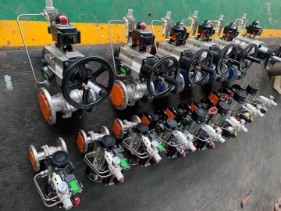
Option Accessories
- Pneumatic/electric actuator
- Handle/handwheel
- Limit switch
- Solenoid valve
- Volume booster
- Lockup valve
- Gear operator
Product: Fire Safe 2-Piece Forged Ball Valve
Fire Safe 2-piece forged ball valve commonly used for the oil and gas industry, and body material available in carbon steel, stainless steel, and other alloy steel.
- Valve Size: ½” to 8″
- Nominal Pressure: ANSI 150/300/600/900/1500LB RF
- Max. Pressure: 1,480 PSI at 100º
- Connect Ends: Flanged Ends
- Design Standards: ASME B16.34, API 6D, NACE MR-0175
- Testing Standards: Fire Safe, API 607, API 598
- Certificate: ISO 9001, CE, API 607.
Fire Safe 3-Piece Ball Valve
Three-Piece Cryogenic Ball Valve
When the media is liquid oxygen, liquid nitrogen, and other liquefied gases, the valve is at extremely cryogenic application, we need specially designed ball valves to meet the equipment for reliable operation, and minimal heat exchange between the fluid and the environment.
For most cryogenic liquefied gases, with cryogenic temperatures as low as -450F, the valve will operate hundreds of degrees Fahrenheit below ambient temperature. Therefore, our ball valves and bonnets need to be designed with thermal expansion in mind, not only by completely cleaning and degreasing all parts, but also by taking care that the bolts are spring-loaded, the balls are pressure relievable, and the seats have double seals.
At the same time, a special packing design prevents media leakage along the stem axis, and the packing gland compresses the packing to ensure a tight seal between the stem and the body. In extreme cryogenic conditions, we use a longer stem and design the packing gland to be farthest from the cryogenic temperature. The bonnet is bolted to the valve body and uses a locknut with a resilient washer to ensure a secure connection to the valve body.
A pressure relief hole is typically designed at the upstream end of the ball to prevent overpressure due to thermal expansion. Therefore, cryogenic valves have specific inlet and outlet ends, and we will indicate the flow direction on the nameplate and valve body.
In the cryogenic environment, moisture condensation will freeze on the surface of the ball or cause thermal contraction of the ball valve material, and the valve torque will increase sharply, so in the selection and calculation, the safety factor of torque should be considered so as not to cause too little torque of the actuator and not to open the valve.
Three-Piece 1,000/2,000 W.O.G PSI Ball Valve
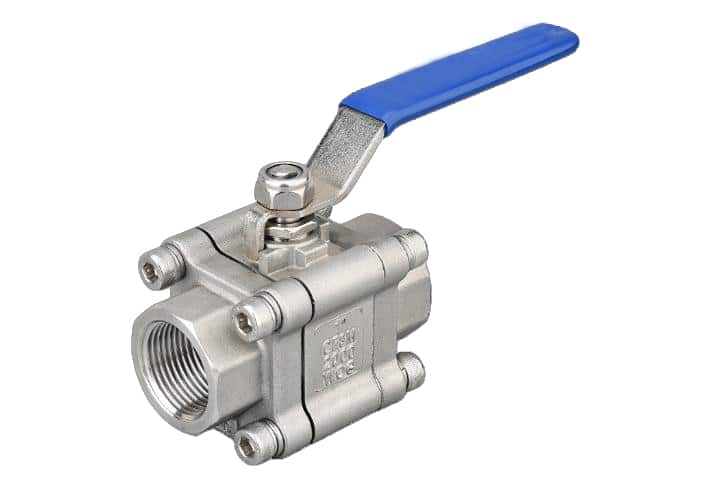
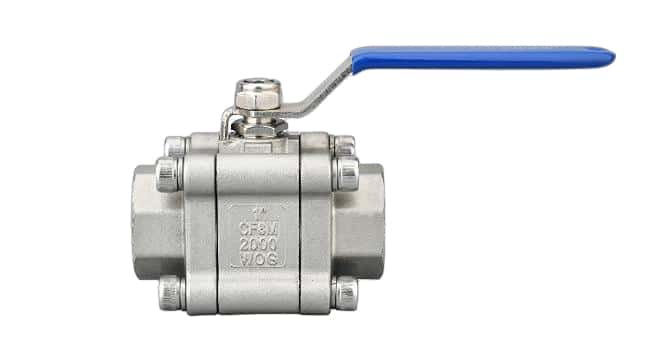
- Description: 3-Piece Standard Port Ball Valve
- Valve Size: ½” to 2″
- Max. Pressure: 2,000 PSI
- Materials: Carbon steel, Stainless steel
- Connections: Threaded, SW Ends
- Design Standards: ASME B1.20.1, ASME B16.11, ASME B16.34, NACE MR-0175, MSS-SP 72
- Testing Standards: Fire Safe, API 598, API 607
- Certificates: ISO 9001, CE.
Three-Piece Multi Ends Type Ball Valve
- Flanged x Tank Bottom Ends Three-Piece Ball Valve
- Flange x Socket Weld Ends Three-Piece Ball Valve
- Flange x Butt Weld Ends Three-Piece Ball Valve
- Flange x Threaded Ends Three-Piece Ball Valve
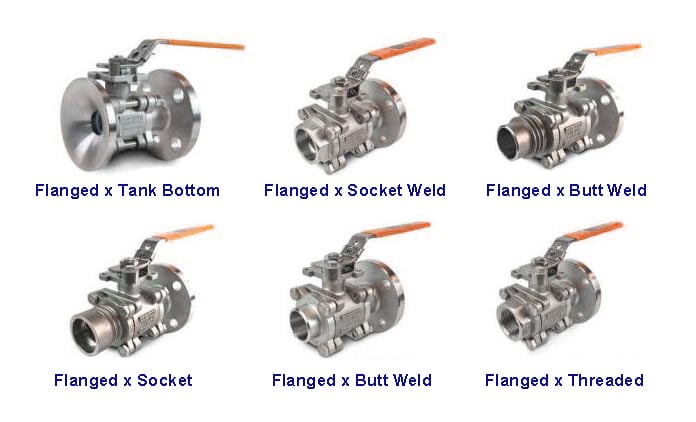
Trunion Ball Valves For Oil & Gas Industry
Trunnion ball valves are widely used in natural gas storage systems, gas transmission, LNG, subsea refining, desalination CO2 services, and power generation applications.
Valve Size: 2 to 24″
Nominal Pressure: ANSI 150/300/600LB RF
Temperature Range: -50 to 600°F (-45 to 315°C)
Body Materials: ASTM A105, ASTM A350 Gr. LF2, ASTM A182 Gr F316
Connect Ends: Flanged Ends
Design Standards: API 6D, ASME B16.34
Testing Standards: API 598, API 6D
Certificate: ISO 9001, CE, API 607.
Why Use a Trunnion Ball Valve?
Ball valves are designed to turn the flow on/off by rotating a steel ball inside the body through the valve stem.
When the ball passage is in the same direction as the pipeline, the valve is in the open state and the medium can pass downstream. When the ball passage rotates 90 ° with the pipeline, the valve is in a closed state, and the media can not pass.
Since the ball valve only needs closing by rotating 90°, so the ball valve has the function of a fast closing. It is easy to monitor the open or closed status of the valve by the indication of the handle or limit switch. Soft seat ball valves, which also have a tight seal for a long service time, can achieve zero leakage.
While the trunnion ball valve has all the advantages of a normal ball valve, its design features a trunnion fixed at both the top and bottom of the ball, providing a positive seal on the upstream and downstream seats. So regardless of pressure, double block and bleed, or double isolation and bleed function is possible.
This special design reduces the torque required for valve action and is more suitable for large bore and high pressure operation, making the trunnion design ideal for the oil and gas automatic industry.
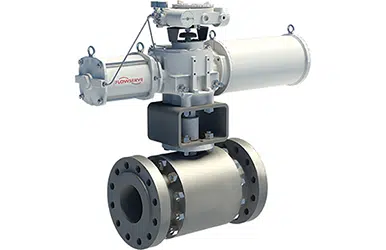
Features & Benefits
- Emergency Sealant Injection
The standard feature of emergency stem sealant injection allows the valve’s stem housing to be adapted to a grease fitting to inject sealant in case of emergency, providing protection against unplanned spikes in operating conditions.

The emergency sealant injection feature allows a grease fitting to be used at the end connection of the valve to inject the sealant. This will produce a positive seal in the event of leakage from the valve seat due to impurities or unexpected increases in operating conditions.
- Double Block and Bleed
This safety feature eliminates pressure buildup due to high pressure media trapped in the valve cavity, even when the valve is in the fully closed position.
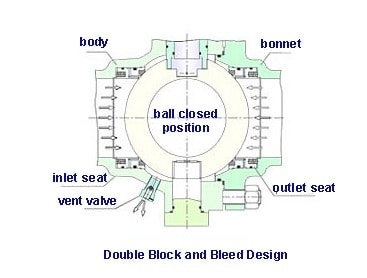
- Firesafe Design
According to API 607 fire-safe standard, there are secondary metal seat designs in trunnion ball valves. The secondary graphite body seals and flexible graphite packing respectively prevent fluid leakage through the body joints and stuffing box.


- Drain and Vent Ports
A vent port at the bottom of the valve releases any liquid trapped in the cavity of the closed valve body. A vent port at the top of the valve body cavity removes residual gas from the cavity of a completely closed valve body. Both play a critical safety role in a dual block and bleed and/or dual isolation and bleed valve configuration.
- Double Seals on Body Joints
The primary elastomeric seal ensures zero leakage under standard operating conditions. The secondary graphite seal ensures proper sealing of the body connection in accordance with API 607 under extreme temperature conditions.
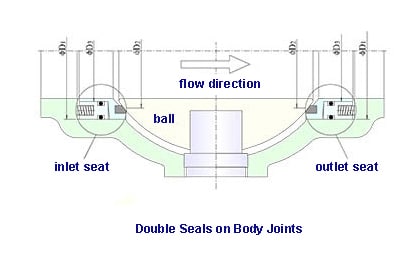
- Blowout-Proof Stem Design
The trunnion ball valve is designed with a special stem to prevent it from blowing out under line pressure.
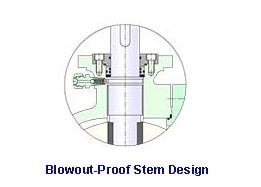
- Anti-Static Devices
An anti-static device ensures that there’s electrical continuity between the ball, the stem, and the body, so the sparks created by a lightning strike or static discharge won’t create sparks inside the valve.
- ISO 5211 Actuator Mounting Pad
The standard ISO 5211 mounting pads provide quick changeover between valves and various types of actuators.
Are trunnion ball valves bidirectional?
Yes, Bi-directional sealing with both upstream and downstream flow applications are the best for trunnion ball valves.
Floating Ball Valve VS Trunnion Ball Valve
What is the difference between a trunnion and a floating ball valve?
In industrial process control, we will see many kinds of ball valves, in general, we are divided into two categories, floating ball valves and trunnion ball valves. This article will tell you when to use which type of ball valve, and what is the difference between them?
- Design differences
The most important difference between these two types of ball valves is the structure of the ball and the way it is assembled.
The floating ball is fixed to the valve body by a single stem only, and the ball is floating on the valve seat. Trunnion ball valves are connected and centered inside the valve body by a shaft/stem at the top and a shaft/trunnion at the bottom.
- Torque
In the floating ball design, the ball is pushed against the downstream seat by in-line pressure, resulting in tightness. When operated from the closed position to the open position, the ball is rotated against the in-line pressure (∆p) and the frictional force of the seat. In other words: the torque required to open and close the ball valve is caused by the line pressure and the nature of the valve seat. As the operating pressure (∆p) and/or valve size increase, the amount of torque required increases significantly. Especially when the seat is a metal seal, the torque can be very high.
Trunnion ball valves are designed with the ball fixed in the center, the ball is held between the stem and the trunnion, which is fixed at the bottom of the valve body. During operation, the inline pressure fits the seat tightly to the ball. Instead of relying on the inline pressure (∆p) and the seat to rotate, only the pressure from the seat to rotate is needed to achieve a tight close.
Therefore, the drive torque required for a trunnion ball valve is usually lower than that of a floating ball valve of the same size and pressure. For example, a DN250 trunnion ball valve has a much smaller actuator than the same DN250 metal-seated floating ball valve, it optimizing the overall package cost. In addition, the trunnion seat design has better stability, which makes it more suitable for extreme conditions, especially for high pressure service conditions.
In Conclusion
Trunnion ball valves are more suitable for high pressure applications and larger pipelines than floating ball valves. Another advantage of the trunnion design over the floating design is that the trunnion usually includes a drain or bleed connection, making it suitable for use as a double safety device. It automatically acts as a relief valve whenever the pressure in the central cavity is higher than the spring force of the valve seat. When it happens, the seat spring is automatically released so that the excess pressure is discharged back into the mains. For these reasons, trunnion ball valves are commonly used in offshore and oil and gas applications.
Although trunnion ball valves require relatively much less torque than floating ball valves, this means that the cost of purchasing actuators is much lower. However, in terms of the cost of the ball valve alone, trunnion ball valves are significantly more expensive than floating ball valves, so as a professional manufacturer, we will be able to advise on the correct ball valve design when selecting and evaluating costs. Please do not hesitate to contact us if you have any questions.
How to quickly understand various industrial valve types and their applications?